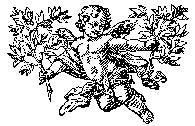![]()
![]()
The COLCHESTER
WAR MEMORIAL
We at Camulos, believe Colchester's War Memorial to be the most beautiful in the whole of England - and probably our finest publicly owned work of art. We believe that those men and women who worked so hard to bring us this monument to our fallen heroes are owed a huge debt by us all.
This web page was created to inform you of how it came to be, together with some technical details of its symbolism, meaning and construction.
The next time that you visit the castle park, please take a small detour to take in the beauty of this wonderful monument, brought to you from a time when people had a very different way of life to how we live our lives today.
The following is an extract taken from:
The eminent sculptor, Mr. W. Reynolds Stephens, wrote in a letter which appeared in The Times of 4th April, 1919, on " War Memorials and the Fitness of Sculpture".
"If the nation wishes to do the greatest honour to her dead heroes and to perpetuate their memory far into the future. then the record of the supreme sacrifice must take a form which possesses:
1. A vivid mental appeal : and2. Be executed in the most imperishable materials that are to be had.
The history of the world shows irrefutably that sculpture in copper and bronze, also a few colossal figures in porphyry and granite, have far outllived everything else." From the Report of the Monument Scheme Sub-Committee presented to the then Mayor (Councillor G. F. Wright) on St. George's Day, 1919 :-
"The following resolution was passed unanimously:
"That no final scheme for a War Memorial for the Borough would be complete which does not include a Monument worthy of the occasion and the Borough as past of that scheme."
From an illuminating paper entitled, "Monumental Memorials and Town Planning," by Professor S. D. Adshead, of the London University, [then] one of the greatest living authorities on the subject :-
"There is an aspect of town planning which may be described as the art of setting monumental architecture, and monumental memorials may be described as the jewels of a monumental town plan.
"Whilst the title of my paper leaves me with sufficient latitude to deal with every kind of memorial that is likely to occur in the embellishment of a town, including buildings of a monumental character, it is obvious that the monumental memorials that are of greatest interest to us at the moment are war memorials, and therefore it is with the design and setting of war memorials that we can most profitably direct our attention.
"It is natural that one whose particular interests are Town Planning should dwell at greatest length on their use and setting, but before doing this it is necessary to consider at some length their especial character and purpose. In all humility, we shall, therefore, in the first instance, invade that territory which, strictly speaking, is the rightful preserve of the sculptor. From the remotest ages it has been the custom of man to memorialise by symbolic representations in ivory, bronze and stone epoch-making events. It is to the utilitarian patriots of last century that must be credited the discovery that a memorial could take the form of a hospital or similar useful institution. I have heard of a small Urban Council who, with an eye to thrift and economy, decided to commemorate the Jubilee of Queen Victoria by the construction of a new public sewer. Needless to say, it is not with such memorials that I am concerned.
"It is generally assumed that the purpose of a war memorial is to celebrate victory, and whilst this is so as regards most memorials that would come under this head, it must be remembered that there are some which it would be more correct to describe as monuments of peace. War memorials have been erected with various ends in view, both for the purpose of inspiring noble action and also, it must regretfully be admitted, for inspiring demoniacal deeds. But the finest. type of memorial is that which, whilst arousing the best sort of patriotism, at the same time holds no sting, innuendo or cruel insinuation either in the volubility of its sculpture or in its massive outline.
To have a great war memorial we must have a great cause, met by a great people and inspired with the noblest ideals. How far removed from this are those German monstrosities of post-Bismarckian days ! How could the blood-and-iron policy of Germany proclaim its barbaric and brutal message 'By the sword shall Germany prosper' other than by expressing itself in the spirit of the unsophisticated, the uncivilised, the archaic and the savage?
"As with all works of art, the nobility of a war monument depends upon the depth of the imagination displayed in its rendering, and to be absolutely sublime it must be symbolic. The modern war god must symbolise his country's power, and the art which memorialise him must rise to symbolic representation.
"The matter of symbolic or realistic representation is one which is at the root of all questions of taste in modern monumental art.
"I would strongly urge that symbolic sculpture, which alone can express those traits of character and mental aspect that are deep, enduring, permanent and noble, as opposed to those which are incidental, is the only type that can be suitably used in connection with the War Memorial.
"And now as to their setting. It is generally recognised that monuments which have been erected in this country during recent years have suffered very much from the lack of a good setting. They either occupy odd corners or odd junctions of streets, and under our existing system of administration their arrival is as often unexpected as their site is unprepared. In the best examples of civic design the monument and its surroundings have been considered together."
We shall see in the following pages how remarkably our monument and its site realise Professor Adshead's ideal.
I conclude my quotations with one from Ruskin :-
"Great nations write their autobiographies in three manuscripts:- The book of their deeds, the book of their words, and the book of their art." Early in March, 1919, a MONUMENT SCHEME SUB-COMMITTEE
was formed. It consisted of :
The late Bishop of Colchester, Colonel C. H. Beatson, C.B.,
The Rev. Canon Brunwin-Hales,
The late Mr. W. W. Bunting,
Dr. Corfield,
Mr. A. Crowther,
Mr. C. T, Gale,
Mr. Edgar A. Hunt (Chairman),
Mr. Percy Sanders,
Rev. W. E. Spencer,
Mrs. Towsey,
Mr. A. Owen Ward; with
The Mayor, Mr. G. F. Wright, ex-officio.
There have from time to time been various changes - some members resigned, e.g., Canon Brunwin-Hales and others were appointed, viz., Messrs. Aldridge, Billington, Bisson, Duncan W. Clark, M. E. Mackriel, Rev. K. L. Parry and Mrs. Alderton. After various meetings it was decided a report should be written by the Chairman. It was presented to the Mayor on St. George's Day, 23rd April, 1919. Early in 1919 the Royal Academy invited sculptors to send in models of war memorials to their Exhibition opening in the May of that year, and Mr. H. C. Fehr submitted his design. It attracted much attention. After much and careful deliberation it was finally and unanimously selected for the Colchester War Memorial Monument. Mr. Fehr is a sculptor of recognised distinction. During the war he considered deeply what form - in his opinion - a war memorial should take, could he produce one entirely from his own imagination - one that was not done to order - one that was not a commission in the carrying out of which he would be more or less trammelled and handicapped by having to observe the wishes, suggestions and conditions of a committee or an individual - one that was simply the inspiration of his own genius - a true "Work of Art. And the outcome was the model in the 1919 exhibition.
The particulars and dimensions of the Monument are as follows :-
Material
Height
Statue of Victory
Bronze
11 feet
Statue of St. George
Bronze
7 feet
Statue of Peace
Bronze
7 feet
Two Panels for Inscription
(excluding wreath)
Bronze
6 feet
The Pedestal is made of selected brown Whitbed Portland stone and is 16 feet over all high. Three steps of hard granite, 25 feet in length and 18 inches wide. The total height of the Monument is 28 feet 6 inches.
The Winged Victory is a figure of exquisite beauty - the poise is perfect. In her right hand she is holding a sword, point downwards so that it represents "The Cross of Sacrifice" and "The Sword of Devotion," and in her left a wreath of laurel. The Eastbourne Monument - also the work of Mr. Fehr - has a very similar Victory, but one a good deal smaller than ours, and it is interesting to note that when it was unveiled by General Lord Horne (G.O.C. Eastern Command) he described it as being the most beautiful war memorial he had yet seen.
The figure of St. George is symbolical of the chivalry and the manhood of England. He is standing on the dead Dragon, emblematical of the vanquished foe. His face, although victorious, is somewhat sad, as though he were thinking of "Our Glorious Dead." On his breast-plate is the Cross of St. George. He is not only the Patron Saint of England, he is the Patron Saint of the Scouts. And on every St. George's Day it would be well for the Scouts of Colchester to visit the monument, think of what the manhood of England accomplished in the Great War, and pray that in their turn they may be able to follow the example set them. They may not all be able to win the highest honour in Knighthood the King can bestow - the Garter of St. George; may the figure in our monument inspire them to try and live up to the ideal of the great Knight who was, "without fear and without reproach."
The lovely figure of a woman representing Peace shows what we strove for, what we hope for - far off as the realisation of our hope seems at present - "Peace on Earth and Goodwill towards Men" - that true Brotherhood of Nations of which we hope the League of Nations may prove the starting point.
But as St. George represents the Manhood, so the figure of Peace represents the Womanhood of England, and reminds us of all the splendid work done by the women of England in general and Colchester in particular.
The three figures give overwhelming proof of what is one of Mr. Fehr's strongest points, viz., his perfect knowledge of anatomy, and his skill in depicting "the human form Divine" - an art which, of course, is shown even more plainly in his exquisite studies of the nude.
The Committee have particular satisfaction in calling attention to the panels, illustrations of which are given. We were resolved that the panels should not be "crowded", that the inscriptions should be short and the lettering large, so that they might be easily read even from some distance. I am afraid Mr. Fehr will think we were very hard to please about the lettering. Unfortunately he was not here when it was again and again under consideration; and finally we decided to send him drawings of what we actually did want. These were the work of a local expert in such matters, Mr. Basil Allen; A.R.C.A., Lond. They are modelled on the lettering of the famous Trajan's Column in Rome; an actual "rubbing " of a portion of which was submitted to us. When he saw them Mr. Fehr was delighted with them and had them photographed. He was good enough to say he considered the words themselves and the lettering were the best he had seen in any panels on his own works or anybody else's.
In the matter of the Borough Arms, etc. Mr. Fehr could not please us by his drawings. He had from the first said be would prefer to send us a model; which we were loth to trouble him to make. But after we decided we must have one after all, in an incredibly short time a beautiful model in clay arrived, showing the glorious wreath, the arms, the ribbon and the singularly appropriate motto, "No Cross, No Crown."
The steps and pedestal - all the stone work, in fact - have been carried out by the well-known local firm of Messrs. L. J. Watts and Company. The beautiful carving on the pedestal is the work of Mr. Magnoni - of Mr. Fehr's studio - and assistants. Mr. Fehr's model has been most faithfully copied. Mr. Duncan Clark kindly undertook the supervision of the work during its construction.
The monument - emblematical, symbolical - is a harmonious whole - a thing of beauty. May it last for ever, and tell the story to future generations to come of how Colchester, by its monument, tried to express, in bronze and stone, thanks to Almighty God for a Great Victory; to commemorate all who fell; to commemorate all who fought; to honour and express its thanks to all the men and women of Colchester who, in any way, helped to win the war.
And may it in some measure fulfil another purpose which I know has been achieved by some other memorials-especially by beautiful memorial chapels. May it be some consolation, some solace, some comfort to the bruised hearts of sorrowing relatives and friends mourning for their lost dear ones. lt shows at any rate Colchester will be ever mindful of them. May it add to the thankfulness and pride of all connected with those who fought but did not fall, of all connected with those who did their duty and strove successfully "to keep the home fires burning." And may it be a great example and inspiration to future generations of Colcestrians for all time.
THE SITE.
BEFORE the report of the Monument Committee was issued in April. 1919, its members had carefully considered what spot in the borough would be, the most suitable site for the Monument. They were unanimously resolved on one thing, viz., that whatever spot was chosen it must stand in the full stream of life - somewhere where it would make a vivid mental appeal, somewhere within sight of where men live and work and pass to and fro on their daily business, somewhere which would not require a special journey to visit it, somewhere where the memory it perpetuates may be the everyday possession of and inspiration to the greatest possible number. In other words, the idea expressed afterwards in Mr. Dudley Clark's beautiful poem on the Whitehall Cenotaph was in the mind of every member of the Committee:
" Not amid cloistering shadows, where the wandering sunbeams stray,
But breasting the murmuring traffic that courses the broad highway:
Where the people are thronging and pressing in the hubbub of All Men's Land,
In the open heart of the Empire, shall the Altar of Empire stand."
In the report they made several suggestions with none of which were they absolutely satisfied. All felt that, provided a scheme could be carried through so that a group of sculpture could be erected on the grass plot in front of the Castle, with the Castle itself as a background to the monument, and so that both could be well seen from the High Street, this would be an admirable site, while a very great public improvement would have been effected. This scheme would have involved the demolition of a long stretch of important business premises in the High Street, and there seemed no chance of any scheme like this until it was announced in May that Lord and Lady Cowdray had given the handsome sum of £10,000 for the purpose of purchasing Colchester Castle and presenting it to the town as their war memorial gift. The sum would cover also the cost of certain property in the High Street (opposite All Saints Church.), part of which was to be demolished in order to open up a wide approach to the Castle.
Here, indeed, was a promise of a happy solution of all difficulties in the selection of a site! Moreover, Colchester itself and all visitors to it would at last realise - without a special journey to it - that it had a splendid Castle practically in its midst. In July, 1920, the Monument Committee unanimously resolved to recommend to the General War Memorial Committee that the Monument be erected on a part of the space to be cleared, so that it can be well seen from the High Street.
It was as yet uncertain what amount of demolition there would be, and to aid all concerned it was decided a sketch map should be produced showing the new property acquired by the Borough, and the Committee were much indebted to the Borough Surveyor and his assistants for the excellent and most useful map that was issued by his office.
It is well to recall what was on the new property: - Messrs. L. J. Watts and Co.'s well-known premises, office, show-room and stoneyard with the familiar high wooden erection on which ran the travelling crane in the air, the stationer's and bicycle shops and a few dwellings. The difference in the level of what was to be the extension of the Park and the old Park was very apparent. And there were some most unsightly black sheds, some belonging to Mr. Round and some to the Castle Inn, which much obstructed the view of the Castle.
In November Lord Cowdray was consulted and his views and wishes ascertained. He was resolved on a very great public improvement. All the land acquired was to form an extension of the Castle Park, and he made use of the memorable words: "The War Memorial Monument must be part of the daily life of Colchester, and must be in full view of the people." He was most anxious there should be a good view of the Castle from the High Street, including the magnificent east front, and expressed the hope that ultimately it might be possible to acquire the S.W. angle of the Holly Trees garden, the walls of which much obstructed this view. He thought Mr. Duncan Clark's scheme of a segment or crescent with the gates of the entrance into the Park behind the Monument a good one, and he much admired the photographs of the model of the Monument Mr. Fehr had exhibited in the Royal Academy. About this date Lord Cowdray wrote :
"I am delighted to know that the Monument Committee have approved of the War Memorial being placed in the centre of the crescent in connection with the new entrance to the Castle Park, It appears to me that the position is an ideal one."
On December 1st, 1920, the Town Council agreed to the necessary demolition, the crescent and the site for the Monument. About this date Mr. Fehr used the memorable expression :
"I am very pleased to have the commission for your monument for three reasons:
1st - Because you have a unique site, which is ideal ;2nd - A monument erected on such a site cannot fail to enhance my reputation;
3rd - Because I believe you will have something that will be really beautiful."
In February our Town Council gave, further proof of its patriotic public spirit by undertaking to do the foundations for the Monument. In July the town was much gratified to learn that Lord and Lady Cowdray had offered £10,000 for the purchase of the Holly Trees Estate for a further great public improvement. The amount of land given with the Holly Trees mansion is 27 acres.
As to the clearing of the space before the gift of the Holly Trees was announced, great credit must be given to Messrs. L. J. Watts and Co. for the public-spirited manner in which they - much to their regret - surrendered their old stoneyard, started a new one elsewhere, and erected new premises, showrooms, etc., in Queen Street. In regard to the other tenants there were many difficulties about the provision for them of suitable alternative accommodation, etc. The housing problem was still acute; but thanks largely to the sustained indefatigable energy and considerate tact of Councillor A. Owen Ward, at last all difficulties were overcome. For his invaluable services in this matter and for the success which at last crowned his efforts - in conjunction with others - to get the unsightly and obstructive black sheds removed, Councillor Ward deserves the warmest thanks of the community.
By November 16th the ground was sufficiently cleared for a combined meeting of the Castle Purchase and the Monument Committee to be held on the spot to finally fix the exact site of the Monument. To assist them a wooden structure had been prepared by the Borough Surveyor - a "profile" or "template" - showing the exact height and width of the Monument. When erected it excited no little curiosity among the passers-by. It could be moved to various positions, so that the effect could be judged.
The gift of the Holly Trees necessitated an alteration of previously arranged schemes. It had been agreed that the Borough could not actually take possession of the Holly Trees during the lifetime of the present tenant, Colonel Davison.
It was therefore resolved to decide on a plan which would ultimately make a very beautiful approach to the Park Extension and to carry out now as much of the plan as is feasible - in other words, Mr. Duncan Clark's design for an enlarged crescent to end in the east side - about where the entrance gates to the stables of the Holly Trees are cannot now be carried out in its entirety, and the crescent must end, for the time being, abruptly against the west wall of the Holly Trees outbuildings.
At the meeting of the Joint Committees the spot on which the Monument now stands was decided upon, opposite the east end of All Saints Church, and in front of the entrance gates to the new part of the Park. The sculptor was present, and in the course of a short speech said :
"I believe if you were to search all England you would not find a more suitable or a more beautiful site for a war Memorial Monument than the one you have got. It is an ideal site."
It transpired at this meeting that it was intended to round off the unsightly sharp angle at the corner of All Saints Churchyard where Queen Street joins the High Street - a very great improvement.
Shortly after the meeting of the Joint Committees, when all concerned were congratulating themselves that all difficulties about the site had been most satisfactorily overcome, there was great dismay when it was learned that after all the plan for the entrance could not he carried out! The new road was to run northward from the gates and turn in the S.W. angle of the "Holly Trees" garden to join the road running in front of the Castle; in other words, the bend or "elbow" was situated on land that did not yet belong to the Corporation. Thus our hopes of placing a "beautiful jewel in a beautiful setting" were in danger of not being realised.
Thereupon the Editor approached Colonel Davison, and pointed the situation out to him, showing how the non-possession of this corner of his garden would prevent the carrying out of a great public improvement, how the proposed road could not he made, how the walls and several trees in the angle obstructed the much-desired view of the east front of the Castle, and how the "back ground" to the Monument seen through the new entrance gates to the Park would be an unsightly one instead of one pleasing to the eye.
Nothing could have been more courteously sympathetic than Colonel Davison's reply, and, in a spirit of true local patriotism, he at once most unselfishly agreed - under certain very reasonable conditions - to surrender the much-coveted piece of ground. At a subsequent meeting of the Town Council it was resolved unanimously that a letter of thanks be sent to Colonel Davison.
In its present condition a true estimate of the great and exceptional beauty of the site cannot be formed. It will be necessary to wait until Messrs. Wallace and Co.'s design for the "lay-out" of the extension of the Park has been carried out, and until the east end of the crescent has been completed. We do not hesitate to say that then the approach to Colchester from the East will be one of the most beautiful entrances to any town to be found in England - a new " beauty spot " will have been created, situated on the Great East Road; a public improvement of almost national importance will have been carried out, mainly owing to the princely generosity of Viscount and Viscountess Cowdray.
THE CASKET
FROM time immemorial it has been customary to place in a niche of the foundation stone of monuments a casket, urn, vase or glass vessel of some sort, containing documents concerning the monument, describing for what reason it was erected, books of local interest, copies of newspapers, coins of the realm, etc., etc. On learning we intended to carry out this custom here, Mr. W. H. Shephard, of 93 and 94, High Street, generously presented the Monument Committee with a handsome terra cotta casket - a product of the famous firm of Doulton & Co., of the Lambeth Pottery Works. When filled with its contents, he hermetically sealed the lid of the casket and affixed a lead seal at each end; which he skilfully stamped with a fine impression of the Borough Arms.
LIST OF CONTENTS.
1 - Names of the Colchester men who gave their lives in the Great -War, 1914-1918.2 - Article by Alderman IV. Gurney Benham, J.P., giving a short history of the Castle and describing the acquisition of the Castle and Holly Trees by the Borough through the princely generosity of Viscount and Viscountess Cowdra.y.
3 - The Report of the Monument Sub-Committee.
4 - A Book, entitled " A Concise Chronicle of the Great War," by Captain R. P. P. Rowe, M.A. (Oxon).
5 - A Set of Medals presented by Lord Cowdray.
6 - Benham's Almanac and Directory for 1922.
7 - " The County Telegraph " Handbook; Directory and Almanac: for 1922.
8 - A copy of " The Essex County Standard."
9 - A copy of " The Essex County Telegraph."
10 - A copy of " The East Anglian Daily Times."
11 - The Victory Day number of "The Illustrated London News," published on 26th July, 1919.
12 - A Local Time Table of Trains; Trams, Motor Omnibuses, etc.
13 - A Memoriandum of the Contents.

The book is now a collector's piece but should be available to see at the local record office, where its full contents can be viewed. Please also remember that our Memorial was a product of the first world war. The second world war brought its own casulaties who have not been forgotten. We have lost many other Colchester men and women in subsequent world conflicts who should also never be forgotten.
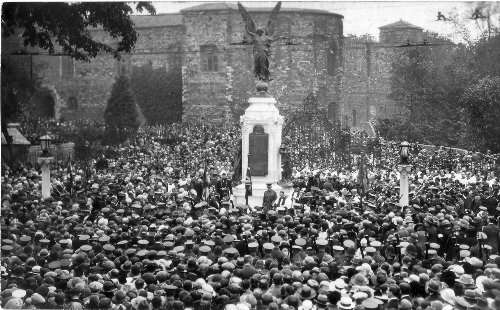
There must be thousands of people in this picture dated from the 1920's. Thankfully, we still commemorate what we now call Remembrance Day on our nearest Sunday to the 11th hour of the 11th day of the 11th month, each year.
The following pictures were taken in October 2006 and demonstrate how well the materials have fared.
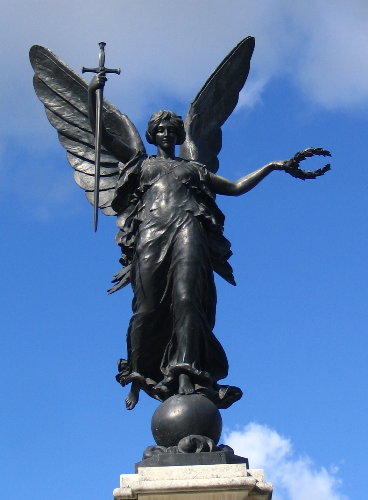
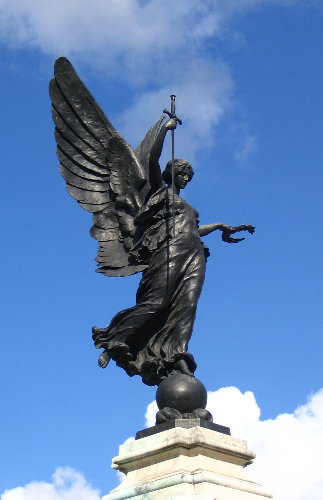
Two views of the Victory statue.
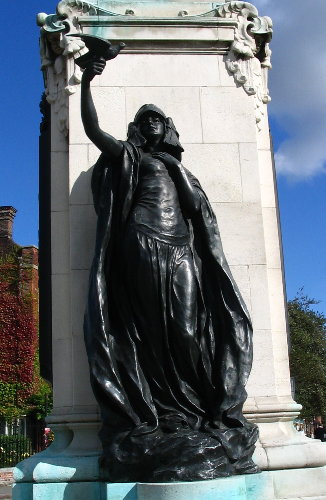
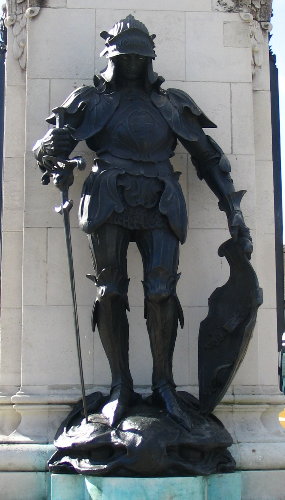
Peace on the left.
St George on the right.
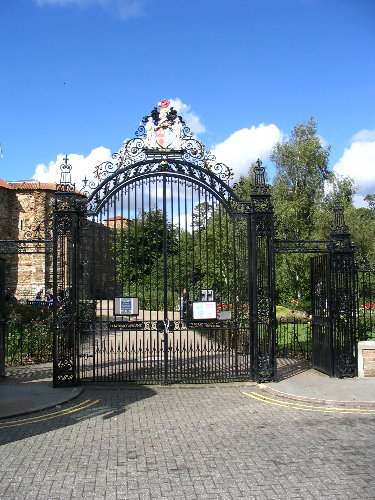
The main gates to the Castle Park, donated by Lord Cowdray and which, together with the Castle, forms part of Colchester's War Memorial
![]()
|
|
|
|
|
|
Remembrance Day
9th November 2008
A large number of people attended, as happens every year.

![]()
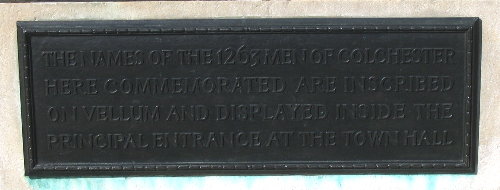
The plaque for the First World War only states:
THE NAMES OF THE 1263 MEN OF COLCHESTER
HERE COMMEMORATED ARE INSCRIBED
ON VELLUM AND DISPLAYED INSIDE THE
PRINCIPAL ENTRANCE AT THE TOWN HALL.
The following picture shows the memorial. The names that are inscribed may be viewed at the link that follows.
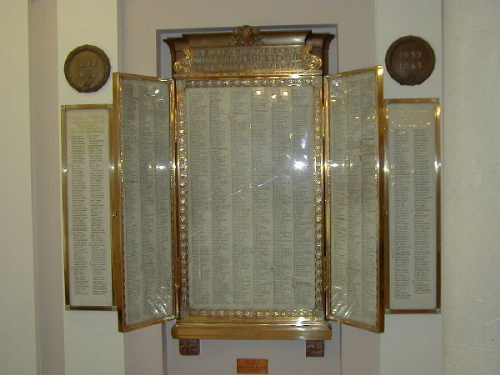
An additional plaque was added after 1945, as shown below.
In 2008, a further addition was made to the memorial as shown below. This was in recognition of:
The members of the armed forces from Colchester killed on duty or as a result of terrorist action since the end of the Second World War.
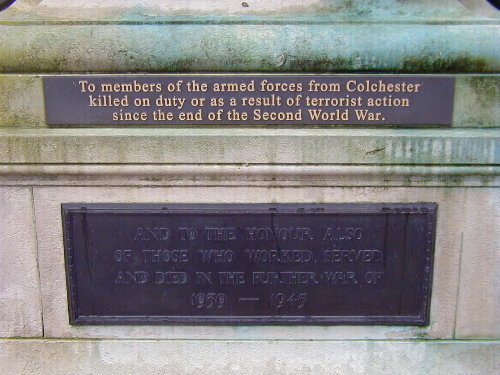
Please view the lists of our fallen heroes elsewhere on our website here.
What do you think? Is our memorial to our glorious dead the most beautiful in England?
or go to the
home page
last updated
11th November 2008
